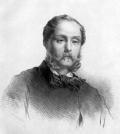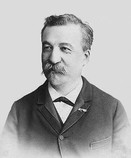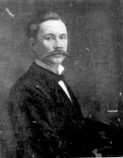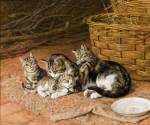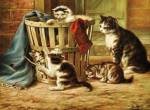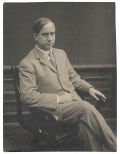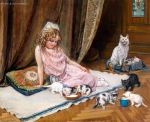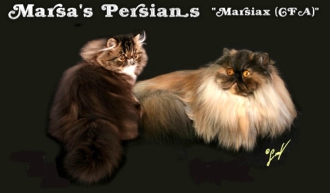
biography of the artists
source Wikipedia the free encyclopedia
Pierre Carrier-Belleuse (* 29. Januar 1851 in Paris; † 1932 ebenda) war ein französischer Maler.
Carrier-Belleuse stammte aus einer Künstlerfamilie: sein Vater war der Maler Albert-Ernest Carrier-Belleuse und der Maler Louis-Robert Carrier-Belleuse war sein Bruder.
Seinen ersten künstlerischen Unterricht erhielt Carrier-Belleuse – gleich seinem Bruder – durch den Vater. Später kam er dann an die École des Beaux-Arts und wurde dort erneut von seinem Vater unterrichtet. Später wurde er auch von Alexandre Cabanel unterrichtet. Durch die Unterstützung von Cabanel wurde es Carrier-Belleuse 1875 ermöglicht, an der großen Jahresausstellung des Salon de Paris teilzunehmen.
Ab dieser Zeit nahm er regelmäßig am Salon teil und wurde 1889 zusammen mit Daniel Ridgway Knight eingeladen, an der Weltausstellung teilzunehmen.
Charles Joshua Chaplin (* 8. Juni 1825 bei Les Andelys, Frankreich; † 30. Januar 1891 in Paris) war ein französischer Maler und Kupferstecher.
Chaplin war ein Schüler Martin Drollings und malte anfangs Landschaften. Später ging er zur Boudoirmalerei über, die er in der Weise des Malers François Boucher ausübte.
Als Kupferstecher fand Chaplin seine Sujets oft in den Werken Peter Paul Rubens' und Jean-Antoine Watteaus; aber er radierte durchaus auch nach eigenen Ideen.
Im Alter von fast 66 Jahren starb der Maler Charles Joshua Chaplin am 30. Januar 1891 in Paris. Er liegt auf dem Friedhof Père Lachaise begraben.
Émile Munier (2 June 1840 – 29 June 1895) was a French academic artist and student of William-Adolphe Bouguereau.
Émile Munier was born in Paris and lived with his family at 66 rue des Fossés, St. Marcel. His father, Pierre François Munier, was an artist upholsterer at the Manufacture Nationale des Gobelins and his mother, Marie Louise Carpentier, was a polisher in a cashmere cloth mill.
Émile and his two brothers, François and Florimond, were talented artists and each spent some time at the Gobelins. During Emile's training he developed a close relationship with his professor Abel Lucas and his family. He eventually married Abel's daughter Henriette.
During the 1860s, Munier received three medals at the Beaux-Arts and in 1869 he exhibited at the Paris Salon. He became a great supporter of the Academic ideals and a follower of Bouguereau, whose subject matter would be an important inspiration to the young Munier.
In 1867, Henriette gave birth to a son, Emile Henri. Six weeks after the birth, having contracted severe rheumatism, Henriette died prematurely. In 1871, Munier abandoned his career as an upholsterer and devoted his time solely to painting; he also began teaching classes to adults three nights a week.
Sargine Augrand, a student of Abel Lucas and a close friend of Émile and Henriette (before she died), caught Émile’s eye; they married in 1872 and lived in a small apartment and studio. Munier frequented the studio of Bouguereau, and they became friends.
In 1885 he painted, and exhibited at the Paris Salon, Trois Amis (Three Friends). This painting, representing a chubby girl playing on her bed with a kitten and a dog, was an extremely successful work, being reproduced in many forms and used for publicity posters by Pears Soap. With this work, Emile asserted himself as one of 'the' painters of young children and their pets; it was eventually acquired by an American collector.
Among his many American patrons were Chapman H. Hyams and his wife, who were important collectors of contemporary French paintings during the nineteenth century and favored artists like Henner, Bouguereau, Gérôme, Vinel and Schreyer. Munier painted their portrait in 1889, and it, along with much of their collection, is now in the New Orleans Museum of Art.
During the 1890s Munier continued to paint peasant, mythological and religious subjects. In 1893 he exhibited L'esprit de la chute d'eau, at the Paris Salon, a nude nymph which is not unlike Naissance de Vénus by Bouguereau.
In 1895 Munier painted La jeune fille et le panier de chatons, but on 29 June, a few weeks after his 55th birthday, he died.
Research on Munier's life and work is being conducted by Rehs Galleries, Inc., New York City.
Josef Arpád Koppay (offizieller Name: Baron Jószef Arpád Koppay von Drétoma), (* 15. März 1857 in Wien; † 2. September 1927 in Badgastein), war ein österreich-ungarischer Maler. Auch die Namen Joszi Arpád Koppay und Josef Arpad Koppay sind in der Literatur nachgewiesen.
Koppay hatte den Adelstitel von seinen Vorfahren väterlicherseits geerbt, Burggrafen in Liechtenstein. Seine Mutter kam aus einer einfacheren Bürgerfamilie Niederösterreichs. Koppay wuchs in Budapest auf, wo er auch zwei Jahre lang Technik und Architektur studierte. In Wien setzte er die Studien fort. Als Architekturstudent war er Schüler von Heinrich von Ferstel, Karl König und Dombaumeister Friedrich von Schmidt. Eine Einberufung in den Militärdienst als Leutnant des Österreich-Ungarischen Feldzugs gegen Bosnien unterbrach sein Studium.
1878, nach dem Feldzug, entdeckte sein Lehrer Schmidt durch Zufall Koppays Aquarelle, die dieser in der Freizeit angefertigt hatte. Schmidt stellte seinen Schüler dem Maler Hans Makart vor, der ihn in seine Meisterklasse aufnahm. Weitere Studien betrieb Koppay bei Hans Canon. Ab 1884 war der Maler in München tätig, wo ihn sein Pastellbild „König Ludwig II. auf dem Paradebett“ (1886) bekannt machte. Dieses Bild war so gut gelungen, dass Koppay für die Kaiserin Elisabeth von Österreich eine Kopie malen musste. Damit wurde er zu einem gefragten Porträtmaler. Er trug den Titel Hofmaler.
Seine Reisen führten ihn an viele wichtige Kaiser- und Königshöfe Europas und in die USA. 1887 zog es Koppay für acht Monate nach Paris. Ende 1887 wurde er nach Madrid gerufen, um dort unter anderem die habsburgische königliche Familie zu malen. Vermutlich Anfang 1888 zog er wieder nach Paris, wo er bis Ende 1889 blieb. Dort verkehrte er mit den Malern Mihály Munkácsy und Léon Bonnat. 1889 reiste er nach London, wo er ungefähr ein Jahr blieb. 1890 zog er nach Berlin und arbeitete in der Reichshauptstadt bis 1894. Er erhielt dort den Auftrag, fast die gesamte Hofgesellschaft und den diplomatischen Korps zu malen. Anschließend ging er nach Wien, wo er bis 1904 hauptsächlich mit Porträtaufträgen beschäftigt war. Ab 1904 arbeitete er jedes Jahr einige Zeit in den USA. In den folgenden sieben Jahren malte er neben dem Hochadel auch zahlreiche Großindustrielle, Künstler und Schriftsteller. Präsident Theodore Roosevelt oder die Familie Rockefeller wurden seine Auftraggeber. 1911 ließ er sich in London nieder. Nach Ausbruch des Ersten Weltkriegs zog er in die neutrale Schweiz nach Zürich. Dort blieb er bis etwa 1919. Nach dem Krieg kam er nach Österreich zurück, wo er zuletzt in Wien lebte.
Er zählte auch zu den hervorragenden Pastellmalern seiner Zeit.
Koppay starb 1927 in Bad Gastein.
John Henry Dolph (* 1835 in Fort Ann, New York; † 1903) war ein US-amerikanischer Kunstmaler, der im Kunsthandel vor allem bekannt für seine Tierdarstellungen, speziell Katzen, ist.
1855 studierte Dolph in Cleveland bei Allen Smith Porträtmalerei. 1863 siedelte er nach New York City über. Da er seine Werke bis dahin schlecht verkaufen konnte, wechselte er nach Antwerpen zu Jean Louis van Kuyck um Tiermalerei zu erlernen. In Paris lebte er von 1868 bis 1873.
Léon Bazile Perrault (* 20. Juni 1832 in Poitiers; † 6. August 1908 in Royan) war ein französischer Maler.
Er war Schüler von François-Édouard Picot und William Adolphe Bouguereau. Nach dem Beginn seiner akademischen Laufbahn als Maler 1861 wurden zahlreiche Werke im Pariser Salon ausgestellt.
Perrault war ein typischer Vertreter des Akademischen Klassizismus. Seine Motive waren mythologische Themen, Akte und Darstellungen von Kindern.
William Oliver, one of the more popular Victorian artists of his time, was known for his lively and realistic depictions of the many picturesque views throughout the Grand Tour (a tour of
continental Europe taken by young men of British aristocracy to complete their education) and the West of England.
Oliver was particularly fond of the Pyrenean area of France and Spain, and completed many small studies of the towns and villages in this area. Many of these small works were then purchased by
the young travelers as souvenirs of their Grand Tour. While he favored painting plein air works, he did complete a number of large and important works during his career – most of which
were either created for specific exhibitions or commissions.
In 1840 he married Emma Eburne, who was an artist and student of his. Like her husband, she specialized in landscape painting and exhibited at numerous public exhibitions.
William was a founding member of the New Watercolor Society and frequently exhibited at the major exhibition halls in London. He died in Halstead, Essex on November 2, 1853.
Today examples of his work are in the collections of the Victoria & Albert Museum, London; Sheffield Art Gallery and Sunderland Art Gallery
Iwan Nikolajewitsch Kramskoi (russisch Иван Николаевич Крамской, wiss. Transliteration Ivan Nikolaevič Kramskoj; * 27. Maijul./ 8. Juni 1837greg. in Ostrogoschsk; † 24. Märzjul./ 5. April 1887greg. in Sankt Petersburg) war ein russischer Maler, Pädagoge und Kunstkritiker. Er war der intellektuelle Führer der Demokratischen Kunstbewegung Russlands von den 1860er bis 1880er Jahren.
Er entstammte einer verarmten kleinbürgerlichen Familie. In der Zeit von 1857 bis 1863 studierte er an der Petersburger Kunstakademie. Er begann bald, sich gegen den akademischen Kunststil aufzulehnen und Anhänger zu finden. Er initiierte den Aufstand der Vierzehn (восстание четырнадцати), der für ihn den Ausschluss aus der Akademie zur Konsequenz hatte.
Unter dem Einfluss der russischen revolutionären Demokraten setzte er sich für die Verantwortung der Künstler gegenüber ihrem Publikum, für das Prinzip des Realismus in der Kunst sowie für die Moral und für die Kunst mit Nationalitätsbezug ein. Er wurde der Gründer und geistige Kopf der Bewegung der Peredwischniki.
In den Jahren von 1863 bis 1868 nahm er eine Tätigkeit als Zeichenlehrer wahr. In der Folgezeit schuf er eine Reihe von Porträts mit den Abbildern der bedeutendsten russischen Schriftsteller, Wissenschaftler, Künstler und Personen der Zeitgeschichte dieser Zeit. Das waren u. a. Leo Tolstoi, Iwan Iwanowitsch Schischkin und Pawel Michailowitsch Tretjakow. Diese Gemälde sind heute in der Tretjakow-Galerie in Moskau ausgestellt. Eines seiner bekanntesten Porträts ist das Bild "Die Unbekannte".
Darüber hinaus schuf Kramskoi Gemälde, die neben seinem Demokratieverständnis und Humanismus auch seine Religion widerspiegeln. Sein Hauptwerk ist das 1872 entstandene Gemälde Christus in der Wüste (Христос в пустыне), was ebenfalls in der Tretjakow-Galerie ausgestellt ist. Auch in der Folgezeit räumte Kramskoi biblischen Themen einen großen Raum in seinen Werken ein.
Sein Stil der Malerei und seine aktuellen kritischen Stellungnahmen zur Kunst seiner Zeit beeinflusste viele Künstler Russlands im letzten Drittel des 19. Jahrhunderts.
Frank Paton (1855–1909) was an English artist of the Victorian and Edwardian eras, best known for his paintings of animals and scenes of rural life. He was a successful artist during his lifetime and could even count Queen Victoria as an admirer of his work. His most famous compositions, "Fairest of Them All" and "Puss in Boots" (1880), have adorned many a wall in the form of plates and posters. In addition, his series of printed Christmas cards published between 1880 and 1909 have become an affordable way for those interested in Paton's art to begin a collection.
Frank Paton was born on 23 November 1855 in Stepney, London, England. His parents were James Paton and Mary Ann Paton (née Ross) and he was the youngest of their seven children. Although Stepney, in the East End of London, was a stronghold for the Paton family, Frank Paton grew up in and around Gravesend, Kent as his father was a maritime pilot (Gravesend, at the mouth of the river Thames, was a pilot station for the port of London).
Unlike his brothers, the majority of whom entered the Merchant Navy, Frank Paton showed an early talent for drawing animals and was allowed to follow his artistic bent. His first known exhibition was at the age of sixteen, the piece being a portrait of a German peasant girl. Family rumour has it that Paton briefly spent time in France working in stained glass before being recalled by his father. It is believed that he then travelled to, and made a living in, Australia. Paton had relatives in Australia - an Uncle and Aunt had emigrated there from London in the 1850s and settled in Williamstown, Victoria - so this is plausible and Australian immigration records of the time show that a Frank Paton, aged 19, an unassisted passenger on the "Shannon" from London, arrived in Melbourne in September 1875.
If Paton did spend time in Australia then it is unclear for how long. What is certain, however, is that he was in England during 1878 as this was the year that his painting "You Are No Chicken" - a modest sized oil on panel featuring two chicks staring at a frog - was accepted by the Royal Academy for exhibition. It was to be a turning point in the young artist's career as the work was purchased by Edward Ernest Leggatt. Although only the same age as Paton, Leggatt was already running a print and art dealership from a Fenchurch Street address in London. You Are No Chicken was engraved in mezzotint by J B Pratt in 1880. Its commercial success cemented a lifelong association with Leggatt, who became the main publisher of Frank Paton's work.
In April 1881 Frank Paton married Mary Sophia Edwards (1852–1929), with the artist Basil Holmes (c.1825 - 1902) bearing witness to the union. Mary, known as 'Marian' within the family. was from Winterborne Houghton in Dorset. She was brought up from an early age by Basil Holmes and his wife Lydia, who was Mary's maternal aunt. Most likely under the tutorage of Basil Holmes, Mary became a talented, amateur artist in her own right as is evident from a pair of etchings by her own hand: "Old Inn Chigwell" and "A Glade near Woodford". After marrying, Frank Paton mainly lived in rural communities in Kent and in Essex.]He divided his time between London and the countryside, accepting commissions for animal portraits from their owners. He was a good family man and raised four sons and three daughters with his wife. Of these, his second eldest son Basil and youngest daughter Dorothy showed considerable artistic talent (the latter becoming a commercial artist and occasionally exhibiting works in public).
Although never a member of the Royal Academy, a total of 20 works by Paton were exhibited at their annual selling exhibition between the years 1878 and 1890. However, Frank Paton is perhaps most widely known for his series of etched Christmas cards published annually by Edward Ernest Leggatt from 1880 until Paton's death in 1909. They were intended to be a cut above the average Christmas card and sold for half a guinea each. Their format became quite formulaic over the years. A central subject reflecting the title of the print was usually complemented by a series of often humorous sketches around its border. A number of the prints would be sent from the printers to be signed in pencil by Paton.
From 1890 Frank Paton no longer exhibited at the Royal Academy following a dispute with the organisers. His reputation firmly established, it was of little consequence and the artist continued to work until his final days. At the time of his death Paton was living in Walton-on-the-Naze, Essex. During the summer of 1909 the family had moved to a new house, which was undergoing alterations and repairs. Paton spent the day of 12 November 1909 discussing and supervising the works with his builder and then in the evening, at around 11.30, suffered a heart attack. Although a doctor was called, Frank Paton died from heart failure at around 5.30 am on 13 November 1909, just 10 days short of his 54th birthday.] In 1919 Edward E. Leggatt donated a full set of copies of Frank Paton's prints to the British Museum. In the inside cover of the Museum's portfolio of the artist is an anonymous tribute to Paton, written shortly after his death. Frank Paton is described as, "A kindly, modest, unassuming man with a rare fund of humour, which is reflected in his etchings. He leaves a large circle of friends and admirers to mourn his untimely and terribly sudden death." Fittingly, Paton's last ever Christmas card was called "The End of the Day".
August Laux, (1847 - 1921) born in the Rhineland area of Germany, August Laux became noted for his richly colored, precisely rendered floral still
lifes and genre scenes, although early in his career his reputation was for frescoes and decorative painting.
His parents were French and relatives held high government positions in Strausburg. A cousin and one of his uncles were sculptors in Paris, and with exposure from childhood to persons creative in the
arts, Laux followed this path. He emigrated to New York City
Robert Braithwaite Martineau (1826 - 1869) war ein englischer Maler.
Er besuchte die Colfes School für ein paar Jahre im Alter von 15 Jahren. Er zunächst als Jurist ausgebildet und später trat der Royal Academy , wo er eine Silbermedaille ausgezeichnet wurde. Er studierte unter dem präraffaelitischen Maler William Holman Hunt und hat einmal das Studio mit ihm geteilt. Er starb im Alter von 43 Jahren. 1865 er heiratete Maria Wheeler und hatte mit ihr zwei Kinder.
Charles Webster Hawthorne (January 8, 1872 – November 29, 1930) was an American portrait and genre painter and a noted teacher who founded the Cape Cod School of Art in 1899.
He was born in Lodi, Illinois and his parents returned to Maine, raising him in the state where Charles' father was born. At age 18, he went to New York, working as an office-boy by day in a stained-glass factory and studying at night school and with Henry Siddons Mowbray and William Merritt Chase, and abroad in both the Netherlands and Italy. In 1908 he was elected into the National Academy of Design as an Associate member and became a full Academician in 1911.
He studied painting under several notable artists] at the National Academy of Design and the Art Students League. Among his teachers were Frank Vincent DuMond and George de Forest Brush. But Hawthorne declared that the most dominant influence in his career was William Merritt Chase, with whom he worked as both a pupil and assistant. Both men were naturally talented teachers and figurative painters who were drawn to rich color and the lusciousness of oil paint as a medium. Chase passed on a Munich tradition of tone values and tone painting, and Hawthorne learned all he could.
While studying abroad in the Netherlands as Chase's assistant, Hawthorne was influenced to start his own school of art.
His winters were spent in Paris and New York City, his summers at Provincetown, Massachusetts, the site of his school. In addition to founding the Cape Cod School of Art, Hawthorne was also a founding member of the Provincetown Art Association established in 1914. While in Paris Hawthorne became a full member of the French Société Nationale des Beaux-Arts in 1917.
The Cape Cod School of Art was the first outdoor summer school for figure painting and grew into one of the nation's leading art schools. Under thirty years of Hawthorne's guidance, the school attracted some of the most talented art instructors and students in the country including John Noble, Richard Miller, and Max Bohm. At his school, Hawthorne gave weekly criticisms and instructive talks, guiding his pupils and setting up ideals but never imposing his own technique or method.
George Sheridan Knowles was born in Manchester in 1863. He painted portraits and genre subjects in both oils and watercolours. The artist was a member of the Royal Institute
of Oil Painters and the Royal Institute of Painters in Watercolours and an associate of the Royal Cambrian Academy in Manchester. Between 1885 and 1893 he exhibited at the Royal Academy, the Suffolk
Street Gallery and the Royal Institute of Painters in Watercolours and was awarded a jury commendation at the Paris Exposition Universelle of 1900.
There can be no doubt that people in the late 19th century looked back at the previous century with great interest and artists such as Knowles catered for this fascination. He captured well some of
the aspects of the bygone era with sensitivity and skill. George Sheridan Knowles died in 1931.
Hedwig Mechle-Grosmann (* 3. Dezember 1857 in Görlitz; † 1. Oktober 1928 in Ödenburg) war eine Genremalerin. Sie entstammte einer künstlerisch begabten Familie mit zwölf Kindern und studierte bei Carl Gussow an der Akademie der Künste in Berlin. Nach ihrer Studienzeit war sie zeitweilig in Paris und Breslau, ließ sich dann aber in Berlin nieder, wo sie 1885 den ungarischen Gutsbesitzer Josef Mechle heiratete. Das Paar hatte fünf Kinder und wohnte zeitweilig auf Mechles Landgut in Nemeskér bei Ödenburg, später in Ödenburg selbst.
Gwendolen Mary John, genannt Gwen John (* 22. Juni 1876 in Haverfordwest; † 18. September 1939 in Dieppe) war eine walisische Malerin.
Gwen John war die ältere Schwester des Malers Augustus John. 1895 studierte sie für drei Jahre an der Londoner Slade School of Art, anschließend folgten vier Monate Malstudien an James McNeill Whistlers Académie Carmen in Paris. 1899 kehrte sie nach London zurück, ließ sich jedoch ab 1904 endgültig in Frankreich nieder. Gwen stand unter anderem dem Bildhauer Auguste Rodin in Paris Modell, woraus eine Liebesbeziehung entstand. Ab 1911 lebte sie in Meudon, einem Vorort von Paris. 1913 trat sie zum katholischen Glauben über, der sie inspirierte: „My religion and my art, these are my life“ („Meine Religion und meine Kunst bestimmen mein Leben“).
Ihr Werk umfasst hauptsächlich Porträts von jungen Frauen, darunter auch Nonnen. Zu Lebzeiten hatte sie nur im Jahr 1936 eine Ausstellung an den New Chenil Galleries in London und erreichte bis zu ihrem Lebensende wenig Bekanntheit. Ihr Bruder Augustus John hatte vorausgesagt, dass sie eines Tages als der bessere Maler von beiden anerkannt werden würde. Seit den 1960er Jahren erschienen mehrere Bücher über sie und Ausstellungen wurden veranstaltet.[1] Ihre Werke sind im Sammlungsbestand so angesehener Museen wie der Tate Gallery in London und dem Metropolitan Museum of Art in New York.
Arthur Hacker, born 25 Sep 1858, London - died 12 Nov 1919 London
Arthur Hacker was the son of the engraver Edward Hacker. He studied at the schools of the Royal Academy (1867-1880) and in Paris
under Leon Bonnet (1880-1881). His style sas influenced by the preraphaelites and the symbolists. Hacker travelled to Spain, Algiers (together with Solomon Solomon) and North Africa. In 1894 Edward
Onslow Ford made a bust of him. In 1910 he became a full member of the Royal Academy. His wife Lilian Hacker was also a painter and she exhibited from 1909 to 1924 at the Royal Academy.
He died in 1919 and was buried at Brookwood Cemetery near Woking. A quote from Shelley's "Adonais" was inscribed on his tombstone.

